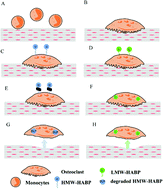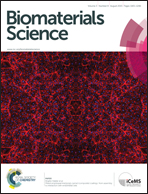Bisphosphonate-functionalized hyaluronic acid showing selective affinity for osteoclasts as a potential treatment for osteoporosis†
Abstract
Current treatments for osteoporosis involve the administration of high doses of bisphosphonates (BPs) over a number of years. However, the efficiency of the absorption of these drugs and specificity towards targeted osteoclastic cells is still suboptimal. In this study, we have exploited the natural affinity of high (H) and low (L) molecular-weight hyaluronic acid (HA) towards a cluster of differentiation 44 (CD44) receptors on osteoclasts to use it as a biodegradable targeting vehicle. We covalently bonded BP to functionalised HA (HA–BP) and found that HA–BP conjugates were highly specific to osteoclastic cells and reduced mature osteoclast numbers significantly more than free BP. To study the uptake of HA–BP, we fluorescently derivatised the polymer–drug with fluorescein B isothiocyanate (FITC) and found that L-HA–BP could seamlessly enter osteoclastic cells. Alternatively, we tested polyvinyl alcohol (PVA) as a synthetic polymer delivery vehicle using similar chemistry to link BP and found that osteoclast numbers did not reduce in the same way. These findings could pave the way for biodegradable polymers to be used as vehicles for targeted delivery of anti-osteoporotic drugs.


 Please wait while we load your content...
Please wait while we load your content...